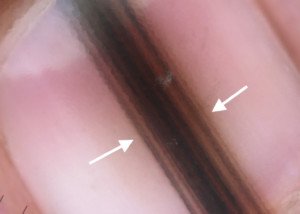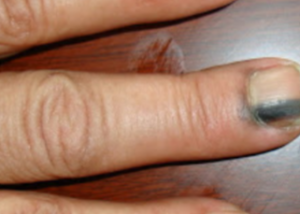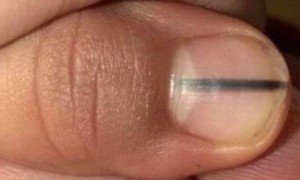
Any race can get nail plate cancer.
Yes, it’s possible and it happens: A nail melanoma being misdiagnosed as a harmless elongated “birth mark” or benign melanonychia.
They can look very similar: nail melanoma (subungual melanoma) and longitudinal melanonychia caused by natural pigmentation, trauma, fungal infection and abnormal (though non-malignant) cell growth.
People of any race can develop melanoma of a fingernail or toenail, but the smallest percentage of patients is in the white population.
Thus, being white doesn’t mean you can’t develop this type of tumor, but being white may mean a lower index of suspicion for a clinician.
So how can you tell a nail melanoma was mistaken for a benign band or smear of pigment?
“If there is a band of pigmentation on a single nail, especially if the band is irregular, with splitting of nail edge or distortion of nail plate; spread of pigment on the cuticle or skin surrounding the nail plate — the nail melanoma is likely to have been misdiagnosed as benign,” explains Vishal Madan, MD, consultant dermatologist, laser and skin cancer surgeon, and founder/director of Everything Skin Clinic™.
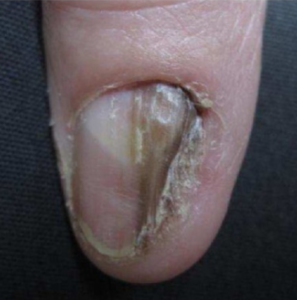
Note splitting of the nail edge and distortion of the plate.
Dr. Madan adds, “One that tapers or has jagged borders with variegated colors.” Another tipoff of a misdiagnosis is that the pigmented band is getting darker and/or wider or thicker.
Yet another reason to suspect a wrong diagnosis is that the pigment on the cuticle or skin surrounding the nail has spread even more, over time, into more surrounding skin.
This spread of pigment is called the Hutchinson’s sign. However – not all nail melanomas have a Hutchinson’s sign.
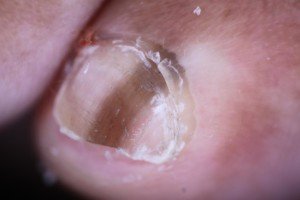
Note the Hutchinson’s sign at the base and beyond. The pigment is actually in the skin, in addition to showing through the cuticle from beneath it.
These signs sound pretty obvious – too obvious for a misdiagnosis to occur. However, melanonychia remains a diagnostic challenge for clinicians.
Why might subungual melanoma be misdiagnosed?
“Regrettably, patients with nail apparatus melanoma are often initially misdiagnosed, and due to diagnostic delays of an average of 2 years, melanoma of the nail unit carries a poor prognosis,” states a paper in Dermatology Research and Practice (Jefferson et al, June 27, 2012).
Misdiagnosis may occur when a low index of suspicion is present, such as with white patients, especially those under 40, and especially children.
Though nail melanoma occurs far more often in blacks than in whites, it also occurs far more often in Mexicans, Japanese, Chinese and Native Americans as well.
However, an index of suspicion may still be low, since there are many non-malignant causes of a dark band, line or smear-like shape below a nail.
In fact, dark skinned people often have a benign pigmented line or band on a nail, and the number of these and/or their width increases with age.
Most black people develop at least one benign stripe on a nail by age 50.
Overall, nail melanoma is an uncommon form of this cancer. However, the poor prognosis is due much more to misdiagnosis than to the nature of the disease.

Specializing in the diagnosis and treatment of all skin conditions including melanoma, Dr. Madan has a special interest in skin cancer treatment, including Mohs micrographic surgery for basal cell carcinoma.
 Lorra Garrick has been covering medical, fitness and cybersecurity topics for many years, having written thousands of articles for print magazines and websites, including as a ghostwriter. She’s also a former ACE-certified personal trainer.
Lorra Garrick has been covering medical, fitness and cybersecurity topics for many years, having written thousands of articles for print magazines and websites, including as a ghostwriter. She’s also a former ACE-certified personal trainer.
.–

